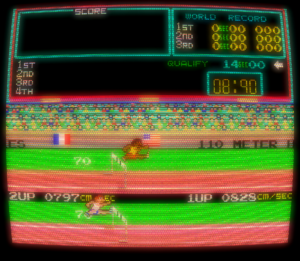 The Game: As a round yellow creature consisting of a mouth and nothing else, you maneuver around a relatively simple maze, gobbling small dots (10 points) and evading four colorful monsters who can eat you on contact. In four corners of the screen, large flashing dots (50 points) enable you to turn the tables and eat the monsters for a brief period for an escalating score (200, 400, 800 and 1600 points). Periodically, assorted items appear near the center of the maze, and you can consume these for additional points as well. The monsters, once eaten, return to their home base in ghost form and return to chase you anew. If cleared of dots, the maze refills and the game starts again, but just a little bit faster… (Atarisoft, circa 1983 [never released])
The Game: As a round yellow creature consisting of a mouth and nothing else, you maneuver around a relatively simple maze, gobbling small dots (10 points) and evading four colorful monsters who can eat you on contact. In four corners of the screen, large flashing dots (50 points) enable you to turn the tables and eat the monsters for a brief period for an escalating score (200, 400, 800 and 1600 points). Periodically, assorted items appear near the center of the maze, and you can consume these for additional points as well. The monsters, once eaten, return to their home base in ghost form and return to chase you anew. If cleared of dots, the maze refills and the game starts again, but just a little bit faster… (Atarisoft, circa 1983 [never released])
Memories: There are only so many ways you can really slice Pac-Man, but this unreleased ColecoVision edition – unearthed just in time for the 2001 Classic Gaming Expo – is one of the better ones.
 It’s slightly faster than usual, so it’s a bit of a challenge, but overall it’s sad that this excellent translation of the coin-op classic didn’t make it to market. Atarisoft, Atari’s prolific division devoted to making third-party software for other consoles and computer systems, had already turned out ColecoVision versions of games like Defender and Jungle Hunt, but for some reason didn’t get around to unleashing Pac-Man – perhaps because they wanted to make sure they “owned” the game on its consoles. (Keep in mind, this is the same Atari that went after Magnavox for the Odyssey2 classic
It’s slightly faster than usual, so it’s a bit of a challenge, but overall it’s sad that this excellent translation of the coin-op classic didn’t make it to market. Atarisoft, Atari’s prolific division devoted to making third-party software for other consoles and computer systems, had already turned out ColecoVision versions of games like Defender and Jungle Hunt, but for some reason didn’t get around to unleashing Pac-Man – perhaps because they wanted to make sure they “owned” the game on its consoles. (Keep in mind, this is the same Atari that went after Magnavox for the Odyssey2 classic  K.C. Munchkin, eventually getting a judge to have the game pulled off the shelves.)
K.C. Munchkin, eventually getting a judge to have the game pulled off the shelves.)
The CGE2K1 edition of Pac-Man sports a ColecoVision-style label, though the artwork of any officially released edition would have been more along the lines of the box art  for the Intellivision version, which can be seen here.
for the Intellivision version, which can be seen here.
And I liked the sinister nuance of the ghosts’ “mean” eyes as they looked downward. Nice touch.

